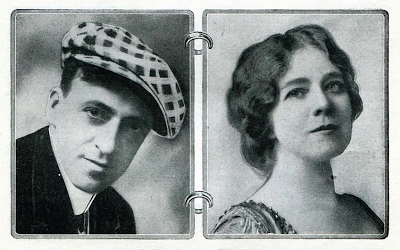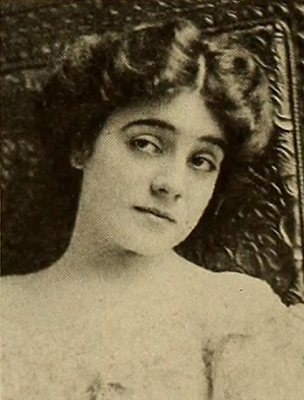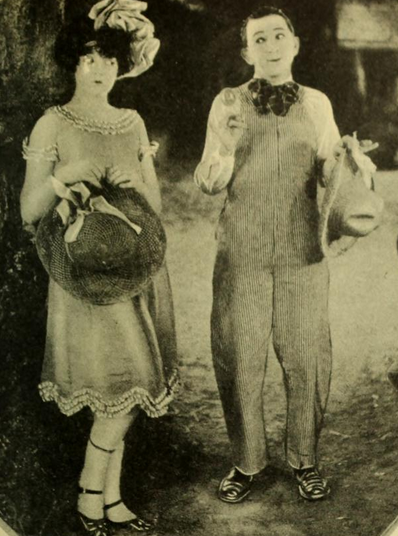Winifred Greenwood toured in vaudeville, performed in musical comedies, and did dramatic stock work before joining the film world. She was versatile, consistent and a hard worker, helping her work consistently through the early days of film and into the early talkies. And she, like so many others, got her start in the movies in Chicago.
Greenwood was born January 1, 1885 in Genesee, New York. Like so many other stars of the silent screen, she got her taste of the limelight at a young age. She told Motography that she made her debut as Leah in “Leah The Forsaken” at the age of 3, filling in for the play's regular little starlet. This taste of the spotlight woke something within Greenwood and by 10, she was performing regularly on stage. She told the film magazines that she toured in vaudeville for three years, traveling with her mother until her mother died. Around 1905, she tried the world of musical comedy before settling on dramatic stage work. She joined a stock company in South Bend, Indiana around 1909 and, she told the magazines, even had her own stock company for a time out of Fort Wayne. The strain of stock work began to get to her, however, and when the opportunity arose to join the Selig Polyscope Co. in Chicago, she accepted, joining the group in roughly April 1911. (It should be noted that, though it's not referenced in any contemporary publications, she is credited as playing Momba in “The Wonderful Wizard of Oz” film from Selig Polyscope in 1910.)
By the time she joined Selig, she had eloped, had two children and divorced, a fact that even shocked the fan magazine reporters at the time. Little Reine and Alonzo were sent to boarding school in Kalamazoo, Michigan while their mother worked, but when he was a little older, Alonzo was given the chance to act on screen in Flying A's “A Pitchfall of the Installment Plan.” Greenwood was with Selig for just over two years, and won praise for her performances in “The Two Orphans” and as spies on opposite sides of the Civil War in “Pauline Cushman, A Federal Spy” and “Belle Boyd, A Confederate Spy.”
Winifred Greenwood in "Pauline Cushman, A Federal Spy"
In July 1913, she announced she had completed her engagement with Selig, and gave lectures on film in South Bend during her downtime. In August, it was announced that Greenwood had joined Flying A in Santa Barbara for a “large salary.” She took on a variety of roles to help expand her wheelhouse beyond the roles given to her at Selig. She was a leading lady alongside Charlotte Burton, and Burton often stepped in to take on roles originally slated for Greenwood when she was sick or injured.
In addition to having the ability to develop her professional life, she made some changes in her personal life. In late 1913, she married fellow actor and director George Field. Although 1914 was a bit of a bumpy year (she was laid up for about a month due to injuries sustained from a motorcycle accident), by 1915 she was receiving some of the greatest reviews of her career. Motography gushed over “When a Woman Waits” saying, “The work of Miss Greenwood...is an almost perfect example of what can be accomplished by an artist through the medium of the silent drama.”
George Field and Winifred Greenwood
In 1916, she seemed to be on her way to super stardom. She was co-starring with Frank Ritchie and slotted to star in Mutual Masterpiece De Luxe productions. She even joined up with Selig again to take part in a new production of “Two Orphans,” featuring her old Selig co-stars Kathlyn Williams and Adrienne Kroell. Then, her contract was included in a $1-million contract between General Films and Balboa Studios, along with stars like Vola Vale. She appears to have briefly went into retirement, but emerged to play leads in four-reeler Fortune Photoplays produced by Balboa. Then, her career began to slow.
She kept working consistently, but she was no longer the star of the picture. In 1919, she began appearing in Paramount films, in Richard Dix and Ethel Clayton vehicles as well as Zane Grey films. She made an uncredited appearance in 1936’s “The Music Goes ‘Round,” but she essentially retired in 1927.
Her husband George had also worked consistently through the early ‘20s, but the couple appears to have split up some time before his untimely death in 1925 from tuberculosis (she declared a divorced status on the 1930 census, and widowed status on the 1940). Regardless, she doesn’t appear to have remarried. Greenwood herself died November 23, 1961.
There was a stigma associated with the movies in the early days of film. “Legitimate” actors were afraid to be associated with them, and film actors were generally looked down on well into the early days of Hollywood (especially by the city's resident citizens). But Greenwood, perhaps more than any other early star, saw the potential film had to offer. In 1913, she told the following to Motography magazine.
“The moving picture artist has as large a scope as any in the theatrical field to improve himself or herself, and also to ‘uplift’ the profession, which the majority of us are anxious to do. I predict a grand, glorious future for the moving picture world, and in time it will be universally recognized as belonging to the ‘legitimate.’”
Want to see the fabulous Winifred Greenwood in action? Watch her in the role of Clara in the Mary Pickford vehicle “M’Liss” below.
















































